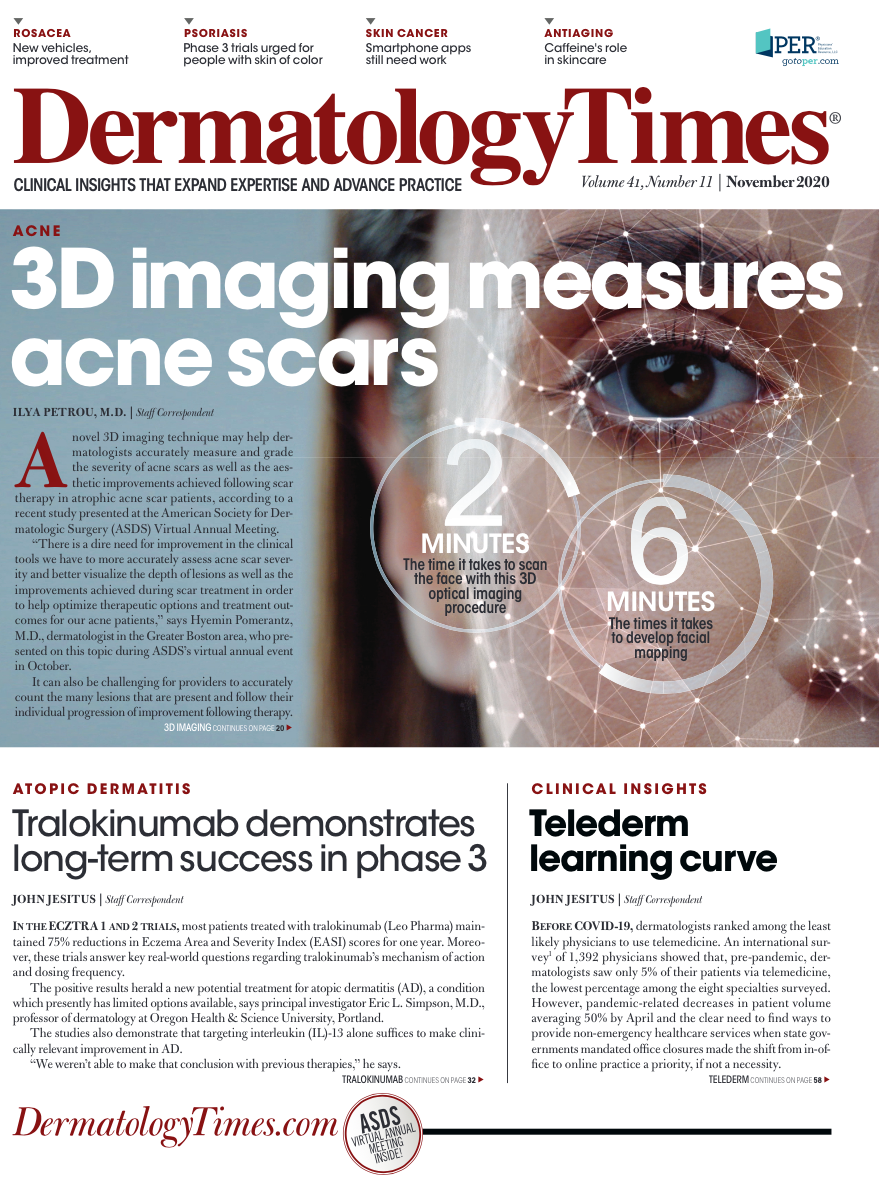- Case-Based Roundtable
- General Dermatology
- Eczema
- Chronic Hand Eczema
- Alopecia
- Aesthetics
- Vitiligo
- COVID-19
- Actinic Keratosis
- Precision Medicine and Biologics
- Rare Disease
- Wound Care
- Rosacea
- Psoriasis
- Psoriatic Arthritis
- Atopic Dermatitis
- Melasma
- NP and PA
- Skin Cancer
- Hidradenitis Suppurativa
- Drug Watch
- Pigmentary Disorders
- Acne
- Pediatric Dermatology
- Practice Management
- Prurigo Nodularis
- Buy-and-Bill
Publication
Article
Dermatology Times
Tralokinumab demonstrates long-term success in phase 3
Author(s):
In clinical trials, most patients treated with tralokinumab maintained 75% reductions in EASI scores for one year.
Trials also address scientific and practical questions
In the ECZTRA 1 and 2 trials, most patients treated with tralokinumab (Leo Pharma) maintained 75% reductions in Eczema Area and Severity Index (EASI) scores for one year. These trials moreover answer key real-world questions regarding tralokinumab's mechanism of action and dosing frequency.
The positive results herald a new potential treatment for atopic dermatitis (AD), a condition which presently has limited options available, says principal investigator Eric L. Simpson, M.D., professor of dermatology at Oregon Health & Science University, Portland.
The studies also demonstrate that targeting interleukin (IL)-13 alone suffices to make clinically relevant improvement in AD.
"We weren't able to make that conclusion with previous therapies," he says.
Additionally, ECZTRA 1 and 2 show what happens when patients who do well for 16 weeks on tralokinumab continue treatment as labeled, reduce treatment frequency, or discontinue treatment.
"Those are all clinically relevant questions that clinicians and patients ask," he says.
Investigators randomized nearly 1,600 patients with moderate-to-severe AD to tralokinumab 300 mg every two weeks (after a 600-mg loading dose) or placebo for 16 weeks. At week 16, 15.8% and 22.2% in ECZTRA 1 and 2 had achieved Investigator Global Assessment (IGA) scores of 0 or 1 with at least a two-point reduction from baseline, versus 7.1% and 10.9% for placebo. EASI 75 rates among patients treated with tralokinumab were 25% and 33.2%, respectively.
Investigators then re-randomized those who reached EASI 75 or IGA success to continue treatment every two weeks, titrate down to every four weeks or use placebo. At 52 weeks, more than 55% of patients who continued twice-monthly treatment maintained EASI 75, as did approximately 50% of patients treated monthly.
More than 51% of patients who stayed on twice-monthly dosing maintained IGA 0 or 1, versus 39% and 45% of patients who switched to monthly dosing in ECZTRA 1 and 2, respectively. For a significant population of patients, including those who fail current therapies or those using tralokinumab first-line, treatment every four weeks may be an option, says Dr. Simpson.
The conservative design of the studies may understate tralokinumab's real-world effects, he adds. Due to eczema's fluctuating nature, he explains, some patients may have had only mild or perhaps moderate disease by week 52 — and no longer been counted as maintaining their improvement.
Likewise, the high average baseline severity (mean EASI > 30 in all study groups) of patients combined with a two-week pre-study topical corticosteroid (TCS) washout may have led to early rescues that further reduced the drug's effects in the primary analysis.
"A fair amount of patients (35.8% and 22.2% in the ECZTRA 1 and 2 tralokinumab groups) were rescued pretty early,” he says. “This was a monotherapy study. If, over 52 weeks, patients used one day of topical steroids, they were counted as non-responders."
In a secondary analysis, the proportions of patients in ECZTRA 1 and 2 who achieved IGA success with added TCS were 19.1% and 24%, respectively.
"I encourage clinicians to look at the more real-world data where patients are using some topical steroids with their biologic," Dr. Simpson says.
Surprisingly, he says up to 25% or 33% of patients treated with placebo, depending on metric, maintained response for 52 weeks without TCS after stopping tralokinumab at week 16. Perhaps, he surmises, tralokinumab's effects manifest somewhat more slowly than other eczema drugs and, in the current analysis, appear to last much longer.
Side effects were rare — 7.1% and 3.0% of patients treated with tralokinumab in ECZTRA 1 and 2 developed conjunctivitis during maintenance, vs 2% and 1.5% for those treated with placebo.
The long-term nature of the trials, moreover, allowed investigators to capture additional successes after week 16.
"For some patients, week 16 may not be your decision point. If you see some response, think about not making a change until around week 24," Dr. Simpson says.
DISCLOSURES:
Dr. Simpson reports receiving grants and personal fees from AbbVie, Lilly, LEO Pharma, Pfizer, Regeneron and MedImmune; grants from Galderma, Kyowa Hakko Kirin, Merck, Novartis, Tioga and Celgene; and personal fees from Boehringer Ingelheim, Dermira, Dermavant, Forte Biosciences, Incyte, Menlo Therapeutics, Ortho Dermatologics, Pierre Fabre Dermo-Cosmetique, Sanofi and Valeant. The ECZTRA 1 and 2 studies were sponsored by LEO Pharma.
REFERENCE:
Eric Simpson MD, Andrew Blauvelt MD, Emma Guttman-YasskyMD, PhD, et al."Efficacy and safety of tralokinumab monotherapy in adult patients with moderate-to-severe atopic dermatitis: Results from two 52-week phase 3 trials (ECZTRA 1 and 2)," American Academy of Dermatology VMX. June 12, 2012.







